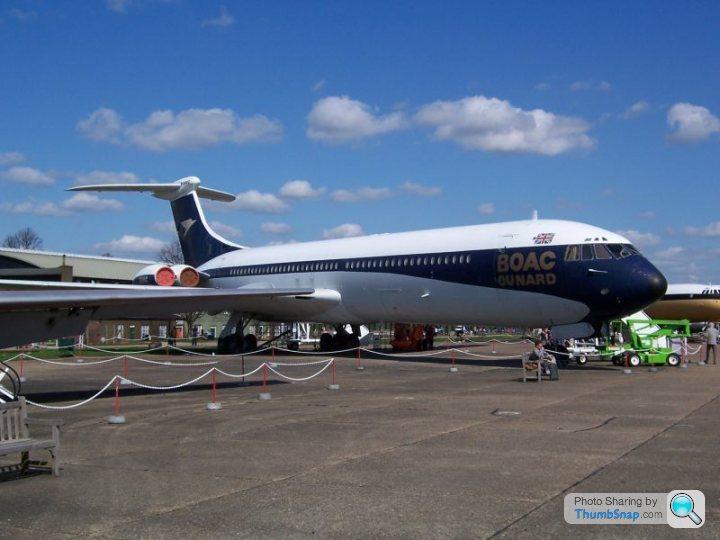What's this aircraft?
Discussion
Silver993tt said:
The length is the same as the Airbus but the VC10 has a larger wingspan, presumably because it's a much older and inefficient design.
The VC10 has a highly efficient wing. The a/c was designed to be able to operate off short runways at 'hot and high' airports (eg Nairobi) where the Density Altitude is against you and the TAS/IAS relationship is poor - the upshot being that the air is effectively too 'thin' for the average wing to produce sufficient lift vs the TORA/TODA (let alone the reduction in Engine Thrust available given the engine designs of the time).The engines fitted to the VC10 in RAF service are RR Conways, giving a tremendous power to weight ratio for its time. Startling performance was achieved at the expense of fuel economy and range, but in the 1960s speed was essential to cross the atlantic. The VC10 was brutal and still is, so the build of the airframe reflects this, it was over engineered and really strong. Some of the airframes had 40,000 - 50,000 flying hours on them and were in good condition, however maintenance costs increase and spares become hard to find or expensive to manufacture. Sometimes though it makes financial sense to move on and replace older aircraft.
Don't forget that the USAF KC-135 fleet is even older than the VC-10s - although much upgraded over the decades.
After 40 odd years service, it really is time for the remaining VC-10s to go - although to me they are one of the most beautiful of all the jet transports.
There was a long discussion on the pros and cons of rear mounted jet engines a few weeks ago.
Rear engined aircraft tend to be heavier compared to those of a similar sized aircraft with wing mounted engines. Placing engines on pylons allows the engines to be used as counterweights to alleviate the amount of wing bending that occures under aerodynamic loads. If tail engines are chosen, then the wing structure has to be made stiffer - and therefore heavier.
After 40 odd years service, it really is time for the remaining VC-10s to go - although to me they are one of the most beautiful of all the jet transports.
There was a long discussion on the pros and cons of rear mounted jet engines a few weeks ago.
Rear engined aircraft tend to be heavier compared to those of a similar sized aircraft with wing mounted engines. Placing engines on pylons allows the engines to be used as counterweights to alleviate the amount of wing bending that occures under aerodynamic loads. If tail engines are chosen, then the wing structure has to be made stiffer - and therefore heavier.
anonymous said:
[redacted]
Slightly O/T, have you seen what the parent company offering those Airbuses are offering the licenced engineers for wages and conditions? Look up www.airtanker.co.uk (I think) if you want a laugh, I'll stick to rotary if you don't mind.Edited by statts1976uk on Sunday 28th November 08:58
FourWheelDrift said:
Still one of my favourite aircraft. British craftsmanship and engineering at its best.Used to fly to Iran in them in the early 70's, and I've spent many an hour as a young 'wanabe pilot' in the cockpit drooling over the dials, switches and so on....
Flying for the young will never be the same again

Edited by M-J-B on Sunday 28th November 09:21
Gassing Station | Boats, Planes & Trains | Top of Page | What's New | My Stuff







